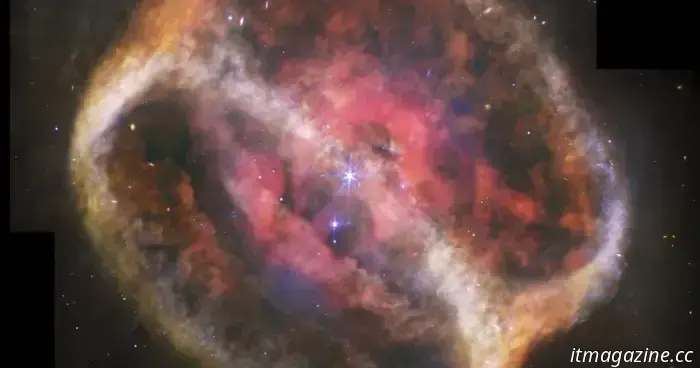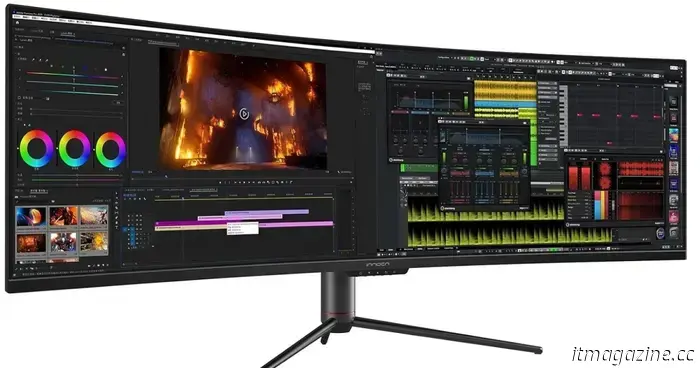
James Webb captures images of a dying star forming a cosmic hourglass.
The James Webb Space Telescope, a collaborative project of NASA, ESA, and CSA, has produced the most detailed image of planetary nebula NGC 1514 to date due to its unique mid-infrared observations. Webb reveals its rings as “fuzzy,” complex clusters of dust, making it easier to observe the holes in the bright pink central region.
This unusual image might resemble a dividing cell or even a brain; however, it is neither. This is actually a space nebula located 1,500 light-years away, known as the Crystal Ball Nebula or NGC 1514. The remarkable structure of this object was formed by the dramatic life cycle of a dying star.
Captured by the James Webb Space Telescope, this image provides unprecedented detail of the nebula. The object had been previously observed by the Wide-field Infrared Survey Explorer (WISE) in 2010, through the efforts of Mike Ressler from NASA’s Jet Propulsion Laboratory. He was later able to revisit the object using Webb’s advanced MIRI (Mid-Infrared Instrument), revealing fuzzy rings that were visible only in infrared, along with some voids near the center.
“Prior to Webb, detecting most of this material was not possible, let alone studying it so clearly,” Ressler commented. “The data from MIRI allows us to thoroughly investigate the chaotic nature of this nebula.”
Two infrared views of NGC 1514 are displayed, with an observation from WISE on the left and a refined image from Webb on the right.
The nebula's peculiar shape is the result of a binary star system at its core. One star in this pair exhausted its fuel, expanded, and shed layers of dust and gas, leaving behind a hot core known as a white dwarf. This dwarf emits weak but rapid stellar winds, shaping the surrounding material. Researchers believe that the presence of its companion star has influenced this material’s hourglass shape, creating the two bright rings.
“When this star was losing material at its peak, the companion might have come very close,” explained David Jones from the Institute of Astrophysics in the Canary Islands, who has also examined this system. “Such an interaction can produce unexpected shapes. Rather than forming a sphere, this could lead to the creation of rings.”
Observations from Webb demonstrate that these rings are not solid; rather, they appear fuzzy and vary in thickness. “We believe the rings primarily consist of very small dust grains,” noted Ressler. “When these grains are exposed to ultraviolet light from the white dwarf star, they heat up slightly, which may make them warm enough to be detected by Webb in mid-infrared light.”
In another update, NASA’s James Webb Space Telescope has inspired a new series of stamps from the United States Postal Service (USPS), highlighting its significant impact on science and astronomy. This month, two new stamps featuring iconic images captured by Webb were issued, one depicting the spiral galaxy NGC 628. “Webb’s observations combine near- and mid-infrared light, showcasing glowing gas and dust in vibrant shades of orange and red, alongside fine spiral shapes that resemble jagged edges,” NASA stated, noting the galaxy is 32 million light-years away in the Pisces constellation.
In further news, a recent image from the James Webb Space Telescope reveals thousands of sparkling galaxies peeking through dust clouds, thanks to its infrared instruments. At the center of the image lies the Spiderweb protocluster, a group of galaxies in the early stages of forming a "cosmic city." The light from the Spiderweb has traveled for an incredible 10 billion years, allowing astronomers to look back to the universe's early stages. This cluster, consisting of over 100 interacting galaxies, offers insights into how galaxies grouped together in the young universe.
Moreover, new images captured by both Webb and Hubble of the same galaxy illustrate why the combination of both telescopes is valuable to scientists. The galaxy NGC 2090 was photographed by Webb using its MIRI and NIRCam instruments, which operate in the mid-infrared and near-infrared parts of the electromagnetic spectrum. As a result, the galaxy's arms, consisting of swirling gas and dust rich in polycyclic aromatic hydrocarbons, appear to glow red. The blue region at the center indicates a cluster of young, hot stars.






Other articles
 Take advantage of this 49-inch ultrawide curved monitor, now available at a 20% discount.
The INNOCN 49C1G ultrawide monitor, boasting a 49-inch curved display and a 32:9 aspect ratio, can be purchased on Amazon with a 20% discount.
Take advantage of this 49-inch ultrawide curved monitor, now available at a 20% discount.
The INNOCN 49C1G ultrawide monitor, boasting a 49-inch curved display and a 32:9 aspect ratio, can be purchased on Amazon with a 20% discount.
 Today, LG's highly acclaimed 55-inch B4 OLED is available at a discounted price of $1,000.
The LG 55-inch B4 Series 4K OLED is currently priced at $1,000. You can purchase it at Amazon, Best Buy, and Walmart to save $300 from the manufacturer's suggested retail price.
Today, LG's highly acclaimed 55-inch B4 OLED is available at a discounted price of $1,000.
The LG 55-inch B4 Series 4K OLED is currently priced at $1,000. You can purchase it at Amazon, Best Buy, and Walmart to save $300 from the manufacturer's suggested retail price.
 The trend of AI action figures on LinkedIn is "clearly not sustainable," cautions a UK tech entrepreneur.
According to Mel Morris, the former chairman of King, the company behind Candy Crush, the trend of LinkedIn AI action figures comes with a significant environmental impact.
The trend of AI action figures on LinkedIn is "clearly not sustainable," cautions a UK tech entrepreneur.
According to Mel Morris, the former chairman of King, the company behind Candy Crush, the trend of LinkedIn AI action figures comes with a significant environmental impact.
 How the McMurtry Spéirling achieved the distinction of being the first car to drive upside down.
Car enthusiasts have long wished for extreme downforce to enable cars to drive upside down. The automaker McMurtry has made this dream a reality.
How the McMurtry Spéirling achieved the distinction of being the first car to drive upside down.
Car enthusiasts have long wished for extreme downforce to enable cars to drive upside down. The automaker McMurtry has made this dream a reality.
 This might be your final opportunity to purchase an Oura Ring Gen 3 Heritage for only $199.
Currently, one of the best deals on Amazon is available, and it could expire at any moment. You can grab an Oura Ring Gen 3 Heritage for only $199, so act fast!
This might be your final opportunity to purchase an Oura Ring Gen 3 Heritage for only $199.
Currently, one of the best deals on Amazon is available, and it could expire at any moment. You can grab an Oura Ring Gen 3 Heritage for only $199, so act fast!
 Ranking the episodes of Black Mirror season 7.
Every episode of Black Mirror's seventh season is impressive and deserving of the anticipation and wait. Here is their ranking.
Ranking the episodes of Black Mirror season 7.
Every episode of Black Mirror's seventh season is impressive and deserving of the anticipation and wait. Here is their ranking.
James Webb captures images of a dying star forming a cosmic hourglass.
A fresh image captured by the James Webb Space Telescope reveals the striking impacts of a star nearing the end of its life.
